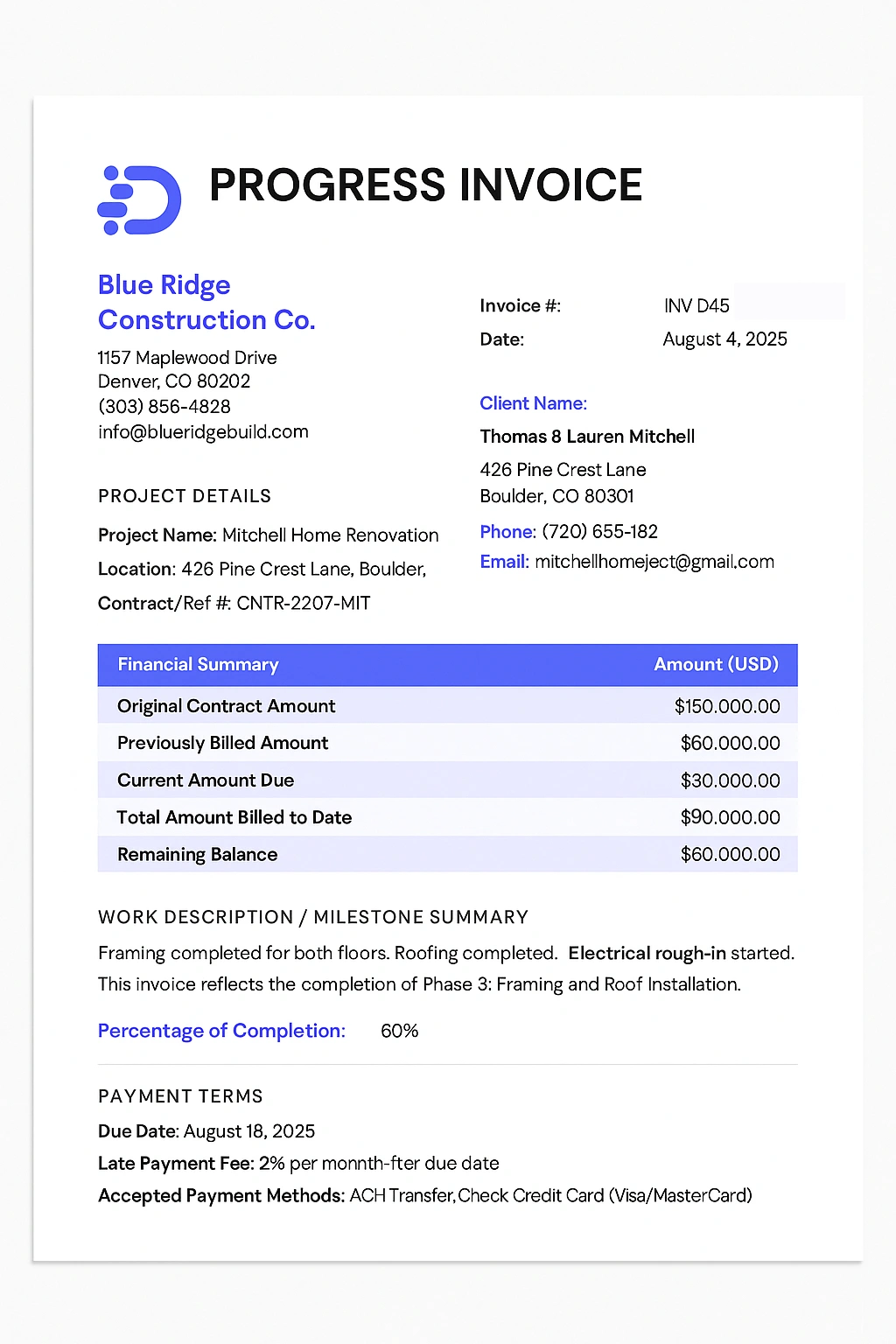A progress payment is a financial arrangement in construction and other project-based industries where the contractor receives partial payments at agreed intervals or milestones as the work advances, rather than waiting until the entire project is completed.
This payment structure ensures that the contractor has a steady cash flow to cover ongoing expenses like labor, materials, and overhead, while also providing clients with a way to pay for work proportionate to the progress made.
Progress payments are usually defined in the contract and can be tied to specific project stages, percentage completion, or pre-agreed timelines. They help minimize financial risk for both parties, contractors avoid funding the entire project upfront, and clients only pay for work that has been completed and verified.
Depending on the type of contract, the method for calculating progress payments may vary, with each approach offering different benefits and considerations.
- Time & Material Contracts: In time and material contracts, progress payments are typically based on the actual hours worked by the contractor’s team and the cost of materials used during a set period. This structure is ideal for projects where the scope is not fully defined at the start, allowing flexibility to adapt as the work progresses. Payments may be made weekly, bi-weekly, or monthly, ensuring contractors can consistently cover labor and supply expenses.
- Lump Sum Contracts: With lump sum contracts, the total project cost is agreed upon in advance, and progress payments are scheduled according to predefined milestones or percentages of completion. This arrangement gives clients a clear view of overall costs from the beginning while allowing contractors to receive funding as major phases of work are finished. Accurate progress measurement prevent disputes over payment timing and amounts.
- Cost Plus Contracts: In cost plus contracts, progress payments reimburse the contractor for the actual costs incurred, such as labor, materials, and equipment, plus an agreed-upon percentage or fixed fee for profit. This type of payment is common in projects where exact costs are hard to predict, but it requires meticulous record-keeping and transparency to ensure the client understands the charges being billed at each payment stage.
- Unit Price Contracts: For unit price contracts, progress payments are determined by multiplying the number of units of work completed by the agreed-upon price per unit. This system works well when project tasks can be clearly quantified, such as paving a specific number of square meters or installing a set number of fixtures. Payments are made based on verified quantities, which helps maintain fairness and accountability between both parties.

How Do Progress Payments Work
Progress payments follow a clear process that ensures contractors are paid for completed work while giving clients confidence they’re only paying for measurable progress. The arrangement starts with detailed terms in the project contract, outlining how and when payments will be made. As work advances, the contractor requests payment for the portion completed, supported by documentation, which is then reviewed and approved before funds are released.
Here’s how the process typically works:
- Define payment terms in the contract – Agree on the payment structure, schedule, and criteria before work begins. Payments may be tied to milestones, percentage completion, or set time intervals.
- Set project milestones or measurement points – Identify specific checkpoints in the project, such as completing the foundation, installing utilities, or reaching a certain percentage of work.
- Perform work according to scope – Complete the project phases as agreed, ensuring quality standards and specifications are met at each stage.
- Submit a progress payment application – When a milestone is achieved, submit a formal payment request with supporting documents like invoices, timesheets, receipts, and progress reports.
- Review and approval – The client or project manager verifies that the completed work meets the agreed criteria before approving payment.
- Release payment – Once approved, the payment is issued, helping cover labor, materials, and overhead for the next phase of the project.
How to Bill for Progress Payments
Billing for progress payments requires accuracy, clear documentation, and a structured process to ensure timely and dispute-free payments. Contractors must demonstrate that the billed work has been completed according to the agreed milestones or percentage of completion in the contract. The process typically involves preparing a payment application that outlines the work performed, costs incurred, and supporting proof, followed by client review and approval before funds are released.
Steps to bill for progress payments:
- Review the contract terms – Confirm the agreed milestones, percentage completion method, or time-based billing intervals, along with any required documentation.
- Track work progress – Maintain accurate records of completed tasks, labor hours, and materials used for each billing period or milestone.
- Prepare the progress payment invoice – Include the milestone achieved or percentage of work completed, detailed cost breakdowns, and the amount due.
- Attach supporting documentation – Add receipts, timesheets, progress photos, inspection reports, or other proof that the work has been completed as claimed.
- Submit the payment request – Send the invoice and supporting documents to the client or project manager as per the contract’s submission guidelines.
- Follow up for review and approval – Maintain communication with the client to resolve any questions or discrepancies promptly.
- Receive and record payment – Once approved, collect the payment and update your project financial records to ensure accurate cash flow tracking.
A progress invoice lets businesses bill in stages for work completed on long-term projects, improving cash flow and tracking milestone progress.
Progress billing is a payment method that lets you invoice clients as work progresses on long-term projects, helping manage costs and maintain clarity.
Ready to streamline your payment operations?
Discover the hidden automation in your payment, billing and invoicing workflows. Talk to our experts for a free assement!

